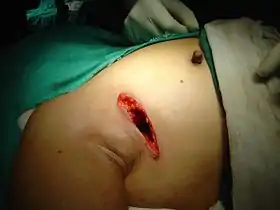Lumpectomy
Lumpectomy (sometimes known as a tylectomy, partial mastectomy, breast segmental resection or breast wide local excision) is a surgical removal of a discrete portion or "lump" of breast tissue, usually in the treatment of a malignant tumor or breast cancer.[1] It is considered a viable breast conservation therapy, as the amount of tissue removed is limited compared to a full-breast mastectomy, and thus may have physical and emotional advantages over more disfiguring treatment. Sometimes a lumpectomy may be used to either confirm or rule out that cancer has actually been detected. A lumpectomy is usually recommended to patients whose cancer has been detected early and who do not have enlarged tumors. Although a lumpectomy is used to allow for most of the breast to remain intact, the procedure may result in adverse affects that can include sensitivity and result in scar tissue, pain, and possible disfiguration of the breast if the lump taken out is significant.[2] According to National Comprehensive Cancer Network guidelines, lumpectomy may be performed for ductal carcinoma in situ (DCIS), invasive ductal carcinoma, or other conditions.[3]
| Lumpectomy | |
|---|---|
 lumpectomy and axillary dissection done through one incision. | |
| Other names | Partial mastectomy |
| ICD-9-CM | 85.21 |
| MeSH | D015412 |
Examples of cancers treated
DCIS, or intraductal carcinoma, is by definition a breast cancer that is limited to the lining of the milk ducts,[4] and accounts for about 20% of breast cancer in the US.[5] Although early treatment of DCIS was similar to invasive breast cancer, involving full mastectomy and sometimes lymph node dissection, an evolution in understanding about the different kinds of breast cancer prompted investigations into the adequacy of less extreme surgical treatments. The results of an eight-year randomized clinical trial in the late 1980s showed that, although lumpectomy alone was associated with significant recurrence, lumpectomy with local radiation therapy achieved similar outcomes to total mastectomy in treatment of DCIS.[6] This was the first substantial data that showed that so-called "breast conserving therapy" was a real possibility.
After a lumpectomy is performed for DCIS, local radiation therapy is typically performed to help eliminate microscopic-level disease. Axillary sentinel lymph node biopsy, as a method of screening for metastatic disease in otherwise non-invasive DCIS, is falling out of favor because the risks of procedure outweigh any effect on outcomes.[7] For DCIS, chemotherapy is not recommended, but tamoxifen may be recommended for tumors which contain an abundance of estrogen receptors.[8]
For patients with invasive ductal carcinoma who have lumpectomies, lymph node biopsy and radiation therapy are usually recommended. Adjuvant chemotherapy is often recommended, but it may not be recommended if the tumor is small and there are no lymph node metastases. For larger tumors, neoadjuvant chemotherapy may be recommended.
Procedure
A lumpectomy is a surgery to remove a breast tumor along with a "margin" of normal breast tissue. The margin is the healthy, noncancerous tissue that is next to the tumor. A pathologist analyzes the margin excised by the lumpectomy to detect any possible cancer cells. A cancerous margin is "positive" while a healthy margin is "clean" or "negative". A re-excision lumpectomy is performed if the margin is detected to be positive or cancerous cells are very close to the margin.[9] Sentinel lymph node biopsy (SLNB) or axillary lymph node dissection (ALND) may be used to determine if the cancer has progressed away from the breast and into other parts of the body.[10] Sentinel lymph node biopsy is the analysis of a few removed sentinel nodes for the presence of cancerous cells. A radioactive substance is used to dye the sentinel nodes for easy identification and removal.[2] If cancer is detected in the sentinel node then further treatment is needed. Axillary node dissection involves the excision of lymph nodes connected to the tumor by the armpit (axilla). Radiation is usually used in conjunction with the lumpectomy to prevent future recurrence.[11] The radiation treatment can last five to seven weeks following the lumpectomy. Although the lumpectomy with radiation helps to decrease the risk of the cancer returning, it is not a cure and cancer may still come back.[12]
References
- "Breast lump removal: MedlinePlus Medical Encyclopedia". medlineplus.gov. Retrieved 2018-11-07.
- "Lumpectomy - Mayo Clinic". Mayoclinic.org. Retrieved 19 April 2018.
- "Lumpectomy". Desertsurgical.com. Retrieved 19 March 2013.
- "Ductal Carcinoma In Situ (DCIS)". PubMed Health Glossary.
- DeSantis C, Siegel R, Bandi P, Jemal A (2011). "Breast cancer statistics, 2011". Ca. 61 (6): 409–18. doi:10.3322/caac.20134. PMID 21969133. S2CID 207727461.
- Fisher B, Redmond C, Poisson R, Margolese R, Wolmark N, Wickerham L, Fisher E, Deutsch M, Caplan R, Pilch Y (March 1989). "Eight-year results of a randomized clinical trial comparing total mastectomy and lumpectomy with or without irradiation in the treatment of breast cancer". The New England Journal of Medicine. 320 (13): 822–8. doi:10.1056/nejm198903303201302. PMID 2927449.
- Zujewski J, Eng-Wong J (August 2005). "Sentinel lymph node biopsy in the management of ductal carcinoma in situ". Clinical Breast Cancer. 6 (3): 216–22. doi:10.3816/cbc.2005.n.023. PMID 16137431.
- "Ductal carcinoma in situ". Getglue.com. Retrieved 19 March 2013.
- "About 20% of Women Need More Surgery After Lumpectomy". Breastcancer.org. 2015-02-05. Retrieved 19 April 2018.
- "Surgery for Breast Cancer". Cancer.org. Retrieved 19 April 2018.
- Fisher B, Anderson S, Bryant J, Margolese RG, Deutsch M, Fisher ER, Jeong JH, Wolmark N (October 2002). "Twenty-year follow-up of a randomized trial comparing total mastectomy, lumpectomy, and lumpectomy plus irradiation for the treatment of invasive breast cancer". The New England Journal of Medicine. 347 (16): 1233–41. doi:10.1056/NEJMoa022152. PMID 12393820. S2CID 4634763.
- "Lumpectomy Plus Radiation". Breastcancer.org. 2015-03-04. Retrieved 19 April 2018.
External links
- Lumpectomy: What to Expect , 19 March 2013
- Breast Lump Removal: MedlinePlus Encyclopedia, 7 November 2018